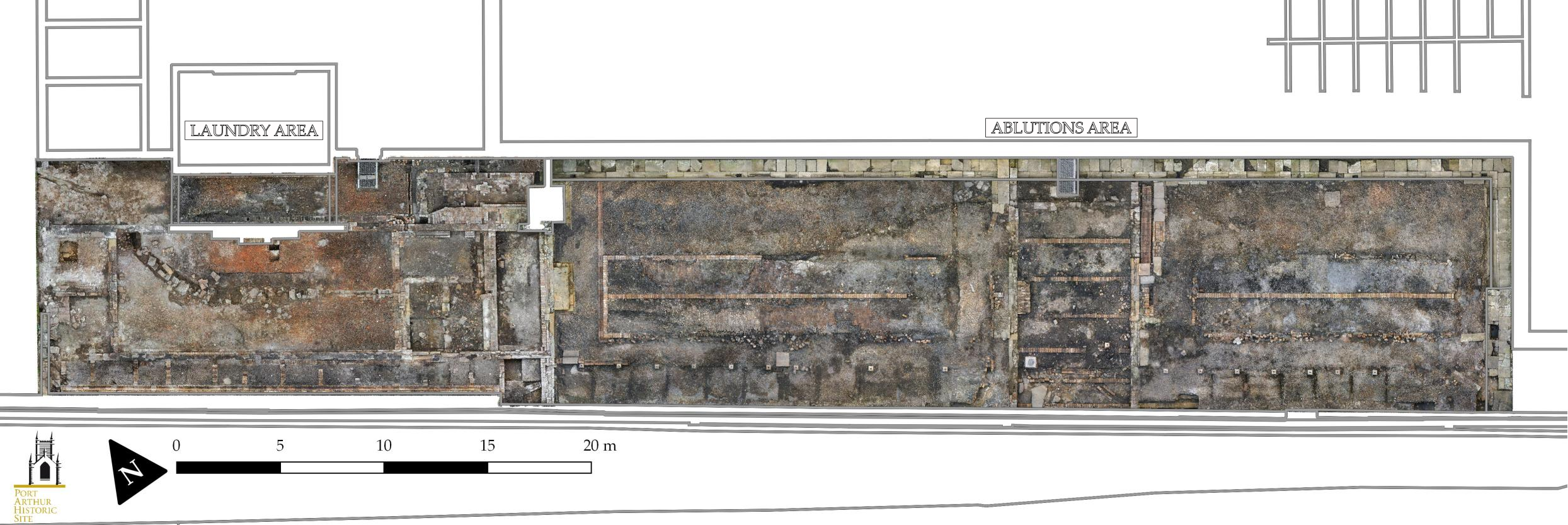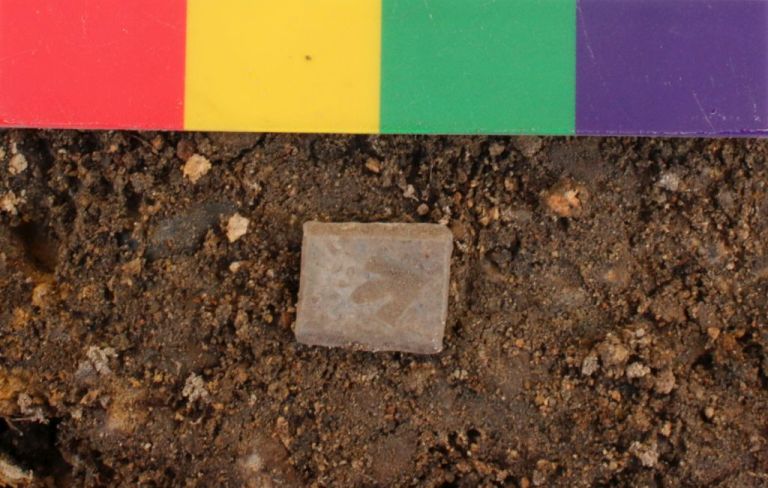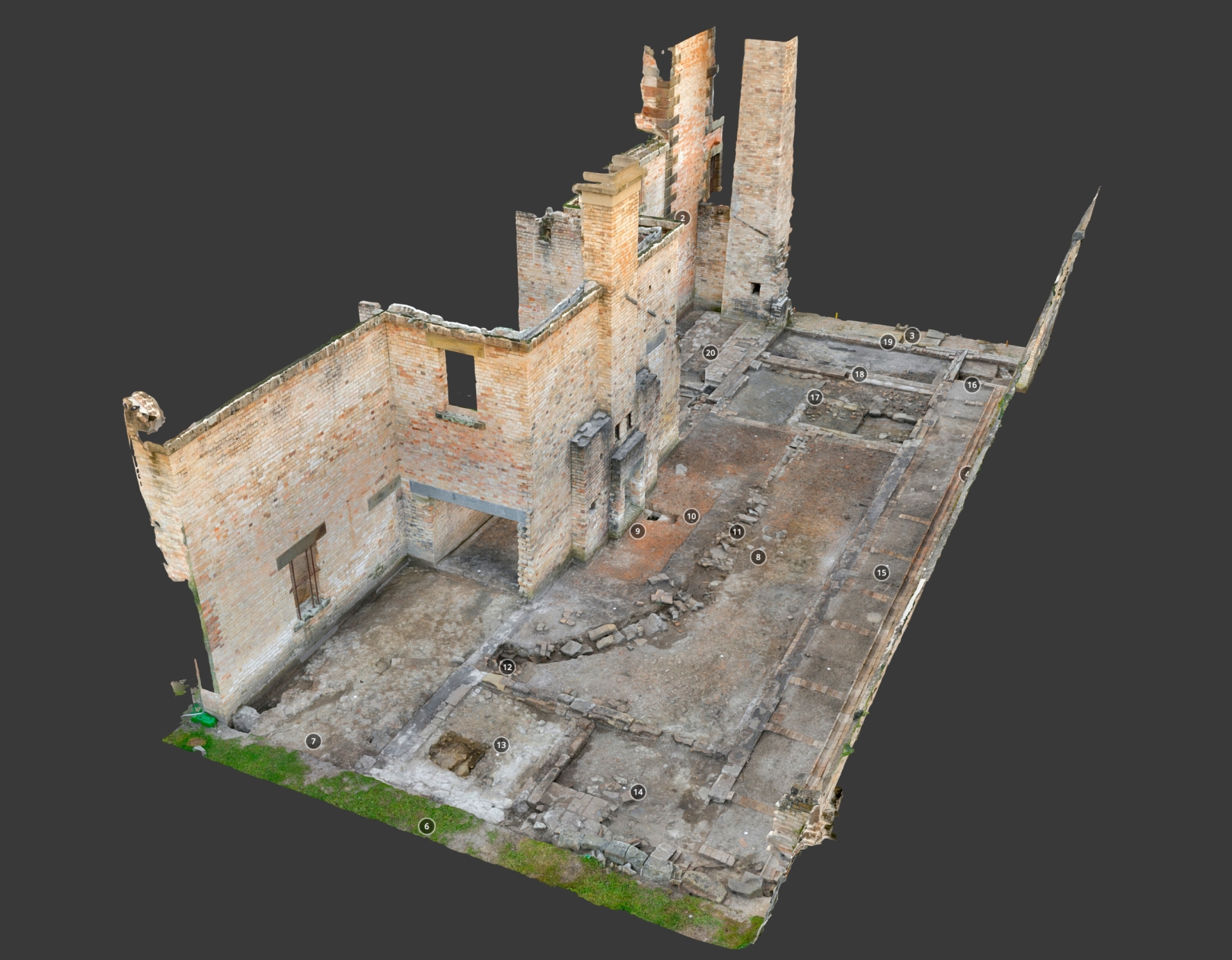Last year was a big year for archaeology at the Port Arthur Historic Site. Over a seven month period, we managed to excavate the full extent of the area at the rear of the Penitentiary. Converted between 1854-56 from an 1840s flour mill and granary, the Penitentiary we see today only represents one small part of the former precinct. Once fronted by a parade ground and flanked by workshops and commissariat stores, the building had been situated within a busy precinct where facilities of incarceration, punishment and welfare operated beside industrial and administrative infrastructure.
The 2016 archaeological excavation focussed on the service-related aspects of the precinct: the ablutions and laundry facilities, exercise yards, shelters and stores which were vital to the operation of the larger building. As such, the investigation provided an opportunity to examine the management of convict welfare and, in particular, how this evolved across the life of the Penitentiary. The ablutions yard was excavated during January–May 2016, with the laundry area investigated during November–December.

Image: Orthophotograph of the full area of excavation, showing deposits and features related to the second phase of occupation (ca.1863-ca.1877)
The archaeological investigations were necessary from a conservation, research and interpretation standpoint. With conservation works ongoing within the Penitentiary precinct since 2011, a decision was taken to use open-area research excavation, instead of undertaking mitigation excavations in reaction to the works. The archaeological results would also feed into interpretation of the precinct. From a research point of view, there was high value in examining an area for which limited information on changes in historical fabric and use existed. The investigations also provided a rare opportunity to engage with the management, welfare and lived experiences of a convict population. This was particularly interesting, as the population under investigation, which after transportation’s cessation in 1854 was an ageing mix of colonially and Imperially-convicted prisoners, has rarely been archaeologically studied.
The excavations revealed a multi-phase site, with features and deposits dating to the Penitentiary period and from earlier phases when the site was occupied by the 1830s waterfront workshops and the 1840s flour mill and granary. The dominant phase represented was related to the Penitentiary, indicative of the disruptive major works associated with the conversion of the precinct from industrial to incarcerative purposes.
In the ablutions area, which accounted for about 2/3 of the area investigated, the first phase configuration had seen exercise yards flanking a centrally-located ablutions block. Surfaced with hardwearing brick and dolerite gravels spread over tons of imported clay, the yards had been fitted with shelters, bench seating and fireplaces. Providing a modicum of protection from the elements, the yards afforded a controllable space where prisoners interacted. In contrast, the ablutions block was a cramped space in which upwards of 480 convicts were expected to carry out basic toiletry requirements morning and evening. It was likely the patently unsuitable conditions in the block that triggered a remodelling of the whole ablutions yard. At some point in the early 1860s, the toilet and washing spaces were removed to the flanking yards, resulting in the demolition of the former compounds and the construction of new shelter sheds in the spaces. The central block was converted to a day room fitted with benches and fireplaces.
Whilst undergoing less of a change, the laundry area, adjoining the western edge of the ablutions yard, similarly went through two major phases of activity. The building originally contained the laundry proper, stores, a bathhouse and washing area, as well as a wood store. When the conversions happened in the 1860s, the building was extended eastwards into the ablutions yard, with a large brick foundation constructed to accommodate a hot water boiler and its associated chimney stack. This boiler provided water to the bakehouse, laundry and washing facilities in the ablutions yard.
The excavation within the laundry area removed all deposits associated with the Penitentiary period. In the ablutions area they were removed down to the first phase of activity, with slots and trenches then excavated to sample the pre-Penitentiary deposits and features underneath. This found that, whilst some evidence of the earlier workshops and flour mill phases remained, the Penitentiary conversion had resulted in the wholesale demolition and removal of any upstanding fabric. What remained were demolition materials and surfaces, and reclamation deposits associated with preparing the area.
A large number of artefacts were recovered from the ablutions area, particularly from the surfaces of the exercise yards and within the central ablutions block/day room (which had had raised timber floors); the position of all diagnostic artefacts was recorded in 3D. In total, the excavation recovered some 1,800 spot finds, including a surprising number of lead and ceramic tokens or gaming pieces. Relatively few artefacts were recovered from the laundry area, likely because a number of rooms had been surfaced with sandstone flagging which would have been regularly swept, but also because the rooms had suffered marked disturbance when the building was salvaged in the post-convict period.

Image: One of the lead tokens in situ. Note the broad arrow!
Reporting to acquit statutory commitments is currently being undertaken, with further publication of key results to come. A number of papers have already been presented on the early results, including the 3D photogrammetry models which were generated throughout the course of the project. These can be viewed at: www.portarthur.org.au/penitentiary-excavation-wraps-preliminary-findings.

Image: Screenshot of one of the 3D photogrammetry models generated during the excavation
We are excited to see what further analysis of the artefacts can tell us; we are particularly interested in their spatial distribution in relation to each other and to the spaces within which they were found. Further historical research also needs to take place, targeting the conduct records to extract information about behaviour and surveillance patterns within the yards.
The area itself will not be going back to the grassed area that it once was. Rather, our interpretation team will be introducing new hard-wearing surfaces and features to interpret the historical use and form of the area.
As always, the excavation would not have been possible without the dedicated band of archaeologists. David Roe and Richard Tuffin would like to thank: for the Penitentiary Ablutions work – Laura Bates, Lauren Davison, Henry Lion, Ronan McEleney, Fiona Shanahan, Rhian Slicer-Jones, and Zvonka Stanin; for the Penitentiary Laundry work – Laura Bates, Emma Church, Lauren Davison, Josh Gaunt, Adam Pietrzak, Michelle Richards and Sam Thomas. Peter Rigozzi was responsible for the amazing ortho and 3D photogrammetry produced during the excavation.

